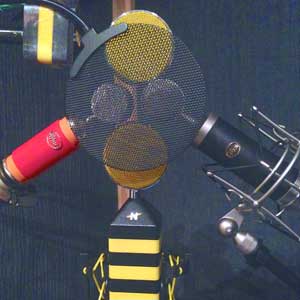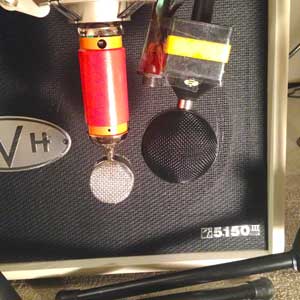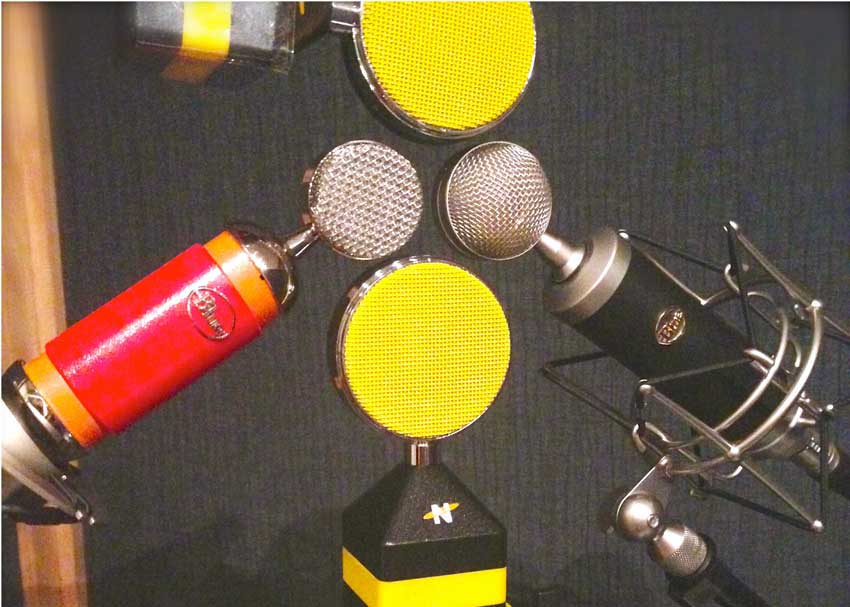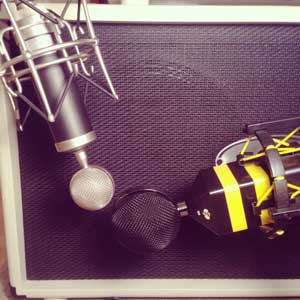Neat Microphones are brand new this year, and everyone’s curious to see how they stack up against other mics. To help you weigh your options, we’ve made recordings comparing Neat’s new King Bee and Worker Bee with two zZounds customer favorite microphones in the same price range — the Blue Baby Bottle and Blue Spark. The Spark has a feature called “Focus mode” that’s designed to add presence and help vocals and instruments cut through the mix, so to help emphasize differences between these four mics, we recorded our Spark in Focus mode throughout the shootout.
Setting Up the Shootout
We recorded three different electric guitars — a PRS S2 Custom 24, a Gibson Les Paul Classic, and a PRS S2 Vela — through an EVH 5150 III guitar amp head and matching 5150 III MX 2×12 cabinet.
After miking up the amp, we plugged our 4 microphones into the mic preamps on a Focusrite Scarlett 18i8 interface feeding Pro Tools at 48 kHz/24-bit resolution.
We also shot out the four microphones on female and male sung vocals, as well as male announcer VO. For the sung vocals, we added each microphone’s custom pop filter; for the VO recording, we tried one large metal pop filter in front of all 4 mics spaced as closely as possible.

It’s weird to speak into this many microphones at a time. I told our VO talent to imagine he was the President giving a speech.
For each recording, we adjusted the Scarlett’s gain knobs so our levels were roughly even on all four channels. We found that the Worker Bee and Spark required a bit more gain to capture the same levels as the King Bee and Baby Bottle, with the Spark requiring the most gain and the Baby Bottle requiring the least gain.
What You’re Hearing on our Shootout Tracks
On each SoundCloud track, you’ll hear one microphone on the following sources in turn:
0:00 – 1:00: PRS S2 Custom 24
1:00 – 2:00: Gibson Les Paul Classic
2:00 – 3:00: PRS S2 Vela
3:00 – 3:32: Female sung vocals
3:32 – 4:08: Male sung vocals
4:08 – 4:36: Male voiceover
May The Best Mic Win!
Here at zZounds, we don’t play favorites — we prefer to let our customers decide! However, here are a few of my personal thoughts…
The Worker Bee performed very well on guitar — very smooth and flattering. Neat Microphones recommends this mic for guitar cabinets, so I’m not surprised.
On the cleaner guitar amp sound, the King Bee and Worker Bee sounded surprisingly similar to me. However, on more distorted guitar amp sounds, the differences were apparent. The King brought out more highs and a bit more lows than the Worker. I would describe the King Bee as more “three-dimensional” than the Worker Bee, but I found the Worker’s character was better suited for guitar amp, while the King was better suited for vocals.

Blue Spark and Neat Worker Bee on guitar cab. See the tape attaching the Worker Bee to its stand? We’re super DIY around here.
Neat Microphones lists vocals as the first application of their King Bee microphone. On male vocals, the Blue Baby Bottle and Neat King Bee outperformed the Worker Bee and Spark, delivering a more present, up-front sound. The Baby Bottle seemed slightly more natural-sounding, while the King Bee was just a hair more forward and “larger-than-life.”
The King Bee was flattering on vocals, especially male vocals. This mic struck me as more “three-dimensional” than the Worker Bee, which made the King Bee particularly well-suited to capturing voices.
On both guitar amp and vocals, the Blue Spark (which was set in Focus mode) brought out a more sharp-edged sound, with lot of emphasis on the midrange and highs. While this character might make the Spark less of an all-purpose microphone, it certainly has its place — for brightening up a dull-sounding source. The Blue Baby Bottle had a very different character than the Spark — it seemed to capture the most low-frequency energy overall.
What are your thoughts on these microphones? We welcome your comments on our SoundCloud!





